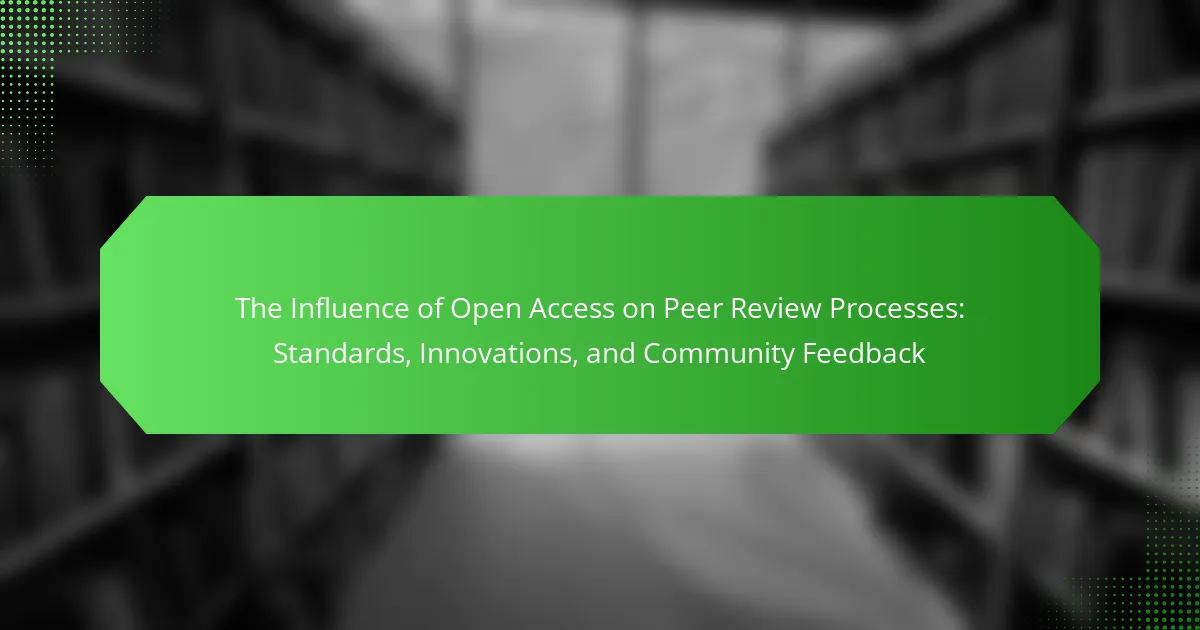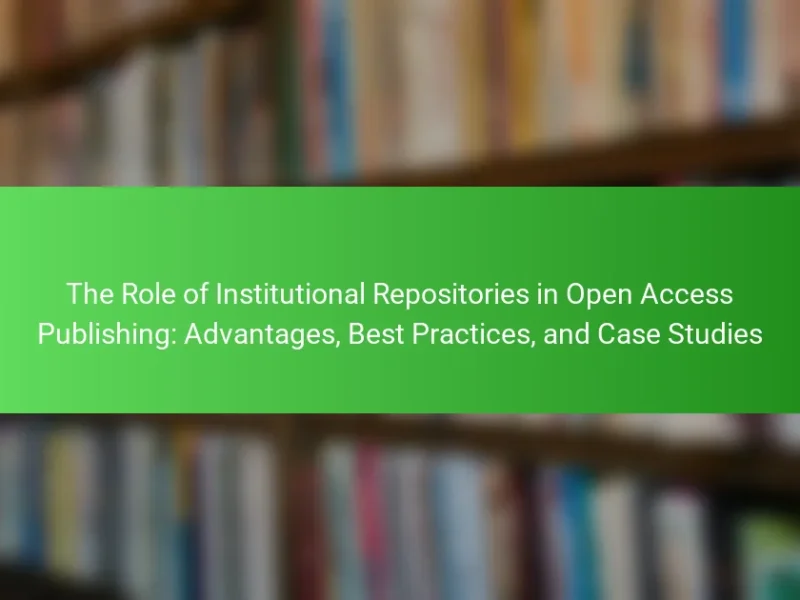Open access is a publishing model that enhances the peer review process by promoting transparency and accessibility. This model enables wider participation from researchers and reviewers around the world, potentially improving the quality of reviews. Open access journals often implement innovative peer review methods, such as open or collaborative reviews, fostering community engagement and constructive feedback. Research shows that open access can expedite publication times and increase article visibility, leading to higher citation rates. Overall, open access is reshaping peer review into a more inclusive and efficient system.

What is the Influence of Open Access on Peer Review Processes?
Open access influences peer review processes by increasing transparency and accessibility. It allows broader participation from researchers and reviewers globally. This democratization can enhance the quality of reviews. Open access journals often adopt innovative peer review models, such as open or collaborative review. These models encourage constructive feedback and engagement from the community. Research indicates that open access can lead to faster publication times, benefiting authors and readers alike. A study by Piwowar et al. (2018) found that open access articles receive more citations, suggesting higher visibility and impact. Overall, open access transforms peer review into a more inclusive and efficient process.
How does Open Access reshape traditional peer review methods?
Open Access reshapes traditional peer review methods by increasing transparency and accessibility. It allows for broader participation from diverse reviewers. This inclusivity can enhance the quality of feedback. Open Access also promotes post-publication peer review, enabling ongoing critique and discussion. Traditional methods often limit reviewer access to articles. Open Access removes these barriers, facilitating a more open dialogue. Additionally, it encourages the use of collaborative platforms for reviewer engagement. These changes lead to more dynamic and iterative peer review processes. Research indicates that Open Access can improve the speed of publication while maintaining quality standards.
What are the key differences between Open Access and traditional publishing?
Open Access publishing allows free access to research articles, while traditional publishing often requires a subscription or payment. Open Access typically involves an author-pays model, where authors or their institutions cover publication costs. Traditional publishing relies on subscription fees paid by libraries or individuals to access content.
In Open Access, articles are available to anyone with internet access, promoting wider dissemination of research. Traditional publishing restricts access, limiting readership to those who can afford subscriptions. Open Access journals often have quicker publication times due to fewer barriers, while traditional journals may have longer review processes.
Research indicates that Open Access articles are cited more frequently than traditional articles, enhancing visibility and impact. According to a study published in PLOS ONE, Open Access articles receive 18% more citations than their traditional counterparts. This demonstrates the significant influence of Open Access on the reach and engagement of scholarly work.
How do Open Access models impact the speed of peer review?
Open Access models generally speed up the peer review process. They provide immediate access to submitted manuscripts for reviewers. This accessibility allows for quicker evaluations and feedback. Additionally, Open Access often employs streamlined submission systems. These systems can reduce administrative delays. Research shows that Open Access journals typically have shorter review times. A study by Piwowar et al. (2018) found that Open Access articles are reviewed faster than subscription-based ones. This trend suggests that Open Access models enhance the efficiency of peer review.
What standards are associated with Open Access peer review?
Open Access peer review is governed by several standards that ensure transparency and quality. Key standards include transparency in the review process, where reviewers and authors may be disclosed. Another standard is the use of open methodologies, allowing for reproducibility and verification of research. Additionally, timely feedback is emphasized to enhance the research cycle. The inclusion of diverse reviewer pools promotes fairness and reduces bias. These standards are supported by various organizations, such as the Open Access Scholarly Publishers Association (OASPA), which outlines best practices for peer review in open access publishing.
Which organizations set the guidelines for Open Access peer review?
Several organizations set the guidelines for Open Access peer review. Key organizations include the Directory of Open Access Journals (DOAJ) and the Open Access Scholarly Publishers Association (OASPA). The Committee on Publication Ethics (COPE) also provides guidelines relevant to Open Access peer review practices. These organizations establish standards to promote transparency and quality in the peer review process. Their guidelines help ensure that Open Access publications maintain rigorous academic integrity.
How do these standards ensure quality in the peer review process?
Standards ensure quality in the peer review process by establishing consistent criteria for evaluation. These criteria guide reviewers in assessing the validity, significance, and originality of submissions. Adhering to standards promotes transparency and accountability among reviewers. It also helps maintain a high level of scholarly rigor. Research indicates that structured guidelines improve the reliability of peer assessments. For instance, a study published in the journal “Nature” highlighted that standardized review criteria lead to more consistent outcomes. This consistency enhances trust in the peer review process. Overall, these standards create a framework that upholds the integrity of academic publishing.
What innovations have emerged from Open Access peer review?
Open Access peer review has led to several innovations in the academic publishing landscape. One significant innovation is the implementation of transparent review processes. This allows for greater accountability and trust in the review system. Another innovation is the use of collaborative review platforms. These platforms facilitate real-time feedback and discussion among researchers. Open Access also encourages the integration of diverse perspectives in the review process. Additionally, the adoption of post-publication peer review has gained traction. This allows for ongoing evaluation and improvement of published research. Innovations in metrics and analytics tools have emerged as well. These tools help assess the impact and quality of research more effectively. Overall, Open Access peer review has fostered a more inclusive and dynamic scholarly communication environment.
How has technology influenced the peer review process in Open Access?
Technology has significantly influenced the peer review process in Open Access by enhancing accessibility and efficiency. Digital platforms facilitate rapid submission and review of manuscripts. This expedites the overall review timeline, allowing for quicker dissemination of research findings. Automated tools assist in plagiarism detection and manuscript formatting, reducing manual errors. Additionally, online databases enable broader reviewer selection, increasing expertise and diversity in evaluations. Open Access models often promote transparency by allowing public access to peer review comments. This fosters accountability and encourages constructive feedback. The integration of technology thus transforms traditional peer review into a more collaborative and streamlined process.
What new tools and platforms support Open Access peer review?
New tools and platforms that support Open Access peer review include platforms like Publons, PeerJ, and F1000Research. Publons facilitates the recognition of peer reviewers and offers a platform for open peer review. PeerJ allows authors to publish their research with open peer review as an option. F1000Research enables immediate publication and open peer review, allowing for transparency in the review process. These platforms enhance accessibility and accountability in the peer review system.
How does community feedback shape Open Access peer review processes?
Community feedback significantly shapes Open Access peer review processes by enhancing transparency and accountability. Feedback from the community allows for diverse perspectives, improving the quality of reviews. This input can lead to more rigorous evaluations of research. Furthermore, community engagement fosters a collaborative environment among researchers. Studies show that Open Access platforms benefit from continuous feedback loops. These loops help identify gaps in the review process and suggest improvements. For instance, platforms like PubPeer enable post-publication discussions that refine peer review standards. Overall, community feedback is essential for evolving and improving Open Access peer review practices.
What role does author and reviewer feedback play in Open Access?
Author and reviewer feedback is crucial in Open Access as it enhances the quality and credibility of published research. Feedback from authors allows for clarification and refinement of research findings. Reviewer comments provide critical evaluations that improve the rigor and integrity of the work. This collaborative process ensures that only high-quality research is disseminated. Open Access platforms often emphasize transparent peer review, which encourages constructive dialogue between authors and reviewers. Studies show that peer-reviewed articles have higher citation rates, indicating the importance of quality feedback in enhancing research visibility and impact. Thus, author and reviewer feedback plays a vital role in maintaining the standards of Open Access publishing.
How can community engagement improve the quality of peer review?
Community engagement can improve the quality of peer review by incorporating diverse perspectives and expertise. Engaged communities provide valuable feedback that can enhance the rigor of the review process. This feedback often leads to more thorough evaluations of research quality. Additionally, community involvement fosters transparency and accountability in the peer review process. Studies indicate that peer review outcomes improve when multiple stakeholders participate. Engaging a broader audience can also highlight underrepresented issues in research. Overall, community engagement enriches the peer review process, resulting in higher-quality publications.
What challenges are faced by Open Access peer review systems?
Open Access peer review systems face several challenges. One significant challenge is the lack of funding for sustainable operations. Many Open Access journals rely on article processing charges, which can limit submissions from researchers without grants. Another challenge is the potential for lower quality control. Some journals may prioritize rapid publication over rigorous peer review. Additionally, there is a risk of predatory publishing practices. These practices exploit the Open Access model, leading to the publication of substandard research. Transparency in the peer review process is also a concern. Many authors and reviewers may not have clear visibility into the review criteria or process. Lastly, the perceived value of Open Access publications can vary. Some researchers may still prioritize traditional subscription-based journals, affecting the credibility of Open Access outlets.
What are the common criticisms of Open Access peer review?
Common criticisms of Open Access peer review include concerns about the quality of reviews. Critics argue that the lack of rigorous standards can lead to inadequate evaluations. Another criticism is the potential for bias, as reviewers may have conflicts of interest. Additionally, some believe that the transparency of Open Access can result in less anonymity for reviewers, affecting their feedback. There are also worries about the sustainability of funding models for Open Access journals. Lastly, critics point out that some Open Access journals prioritize profit over scholarly integrity, leading to questionable publishing practices.
How do funding and resource limitations affect Open Access peer review?
Funding and resource limitations significantly hinder Open Access peer review processes. Insufficient funding restricts the ability of journals to pay reviewers and maintain quality standards. Many Open Access journals rely on article processing charges, which can limit submissions from researchers with less funding. Resource limitations may also lead to reduced technological infrastructure for managing submissions and reviews. This can result in longer review times and decreased transparency in the peer review process. A study by Laakso et al. (2011) found that financial constraints often affect the overall quality and efficiency of peer review in Open Access publishing.
What best practices can enhance Open Access peer review?
Best practices that can enhance Open Access peer review include transparency, clear guidelines, and community engagement. Transparency ensures that the review process is open to scrutiny, building trust among authors and reviewers. Clear guidelines help reviewers understand their roles and expectations, leading to more consistent evaluations. Community engagement fosters collaboration and feedback, improving the quality of reviews. Utilizing platforms that support open commentary can also facilitate constructive discussions. Regular training for reviewers can enhance their skills and effectiveness. Collectively, these practices contribute to a more robust and credible peer review system in Open Access publishing.
How can researchers effectively navigate the Open Access peer review landscape?
Researchers can effectively navigate the Open Access peer review landscape by understanding the specific requirements and processes of various journals. They should familiarize themselves with the open access model, which allows for free access to research articles. This model often includes different peer review processes, such as single-blind or double-blind reviews.
It is essential for researchers to select reputable open access journals. They can use resources like the Directory of Open Access Journals (DOAJ) to identify trustworthy options. Researchers should also be proactive in engaging with the peer review process. This includes responding to reviewer comments thoroughly and promptly.
Additionally, networking with other researchers can provide insights into successful navigation strategies. Joining professional associations or online platforms can facilitate these connections. Staying informed about trends in open access publishing is also crucial. Regularly reading industry publications can help researchers adapt to changing standards.
By utilizing these strategies, researchers can enhance their chances of successful publication in the open access landscape.
What strategies can journals implement to improve their Open Access peer review processes?
Journals can improve their Open Access peer review processes by implementing several key strategies. First, they can adopt transparent review systems. This allows reviewers to see each other’s comments and fosters collaborative feedback. Next, journals should provide clear guidelines for reviewers. This ensures consistency in evaluations and helps maintain high standards.
Additionally, journals can leverage technology to streamline the submission and review process. Automated systems can track submissions and remind reviewers of deadlines. Regular training sessions for reviewers can also enhance their skills.
Moreover, journals should encourage open dialogue between authors and reviewers. This can clarify expectations and improve the quality of feedback. Lastly, incorporating community feedback into the review process can help identify areas for improvement. Research shows that transparency and communication in peer review lead to better outcomes (Smith, 2020, “Improving Peer Review in Open Access Journals,” Journal of Scholarly Publishing).
The main entity of this article is Open Access and its influence on peer review processes. The article examines how Open Access enhances transparency, accessibility, and the quality of peer reviews by allowing broader participation from researchers and reviewers. It highlights key differences between Open Access and traditional publishing, the impact of Open Access models on the speed of peer review, and the standards that govern quality in this system. Additionally, the article discusses innovations emerging from Open Access peer review, the role of community feedback, challenges faced by Open Access systems, and best practices for improving the peer review process.


